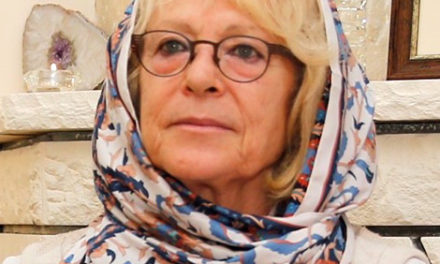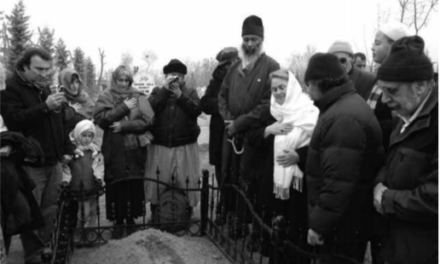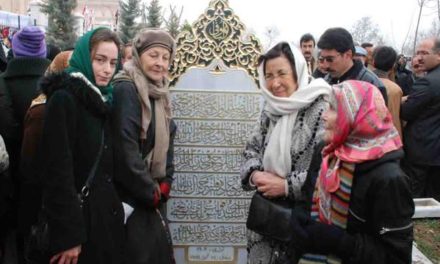Cathryn Goddard, economist and author. She translated in english »Islam, l’autre visage » .
Who is Eva de Vitray-Meyerovitch? How did she emerge from a Roman Catholic family (de Vitray) and survive the Nazi occupation despite the very Russian Jewish name of her French husband (Meyerovitch), to become the voice of Islam’s most widely read poet, Rumi? The mother of two accomplished sons (a doctor and a lawyer), she was also a mystic and a Sufi who provided spiritual nourishment for thousands more through her research and translations.
With over forty publications, she is well known in French-speaking countries. The entire world, however, deserves to know more about her. Although we can never know all of who another person is, the book itself will tell you the amazing tale of the woman who devoted so much of her life to translating the work of others. Allow me here to introduce you to that part of Eva who helped me marvel at the ongoing connections within the vast Universe, in a journey to France, Turkey, Egypt, and beyond.
In 1995, I was observing the first anniversary of my husband’s death, and had spent a few days with French friends near Tours. We stopped in a small bookstore as I prepared to take the train back to Paris. My eyes lit on a title, Anthology of Sufism (in French Anthologie du Soufisme). Tahar had died of a heart attack at 53, a total shock, and I was still groping toward recovery. I had become a voracious reader of books on Sufism, the mystical branch of Islam. Religion would probably not have been invented to deal with birth. Its distant origins are more about coming to grips with our fear of death and our sense of separation at the loss of our loved ones.
The author’s name, Eva de Vitray-Meyerovitch, also attracted me as it seemed to indicate an intercultural or interfaith marriage, which led me to ponder the similarities with my own life. Tahar, a lawyer and a Muslim born in Algeria, always cited the Quran, chapter and verse, to prove there was no need whatsoever for me, an American Protestant, to change religions. That made Islam even more attractive to me: that there was no need to convert! So of course I did, although he often reminded me I had lost nothing of my Protestantism as I continued to protest about everything!
Leafing through the book, I saw Eva’s passion for Rumi. I recalled visiting his tomb and being touched by his presence, when I was a Peace Corps Volunteer in Turkey, before moving to France and meeting Tahar. I could still recall the whirling white skirts of the dervishes, caught between the movement of the cosmos and the spinning of each atom. Lost in reverie, I hesitated and didn’t buy the Anthology because I already had so many books on Sufism. A few days later in Paris walking near the Tuileries Gardens, however, the volume reappeared in a dusty little shop, so I purchased it.
After devouring the text, I knew this odd name would be easy to find in a phone book. Indeed there it was, and I rang the number. Eva, I was told, was not well, but I could call back later in the day and speak to her. Anticipating the call, I marveled that she and I both lived in Turkey and France at the same time, but in that period of my life, I had no particular interest in mysticism.
We spoke in French, although she had fluent English. She was happy to hear from a reader, and we had one of those wonderfully wide ranging discussions that glided from mysticism and grief, to countries, places and poets we loved. She asked if I were a Muslim and I replied that only God could really answer that question. We laughed, because we both had worked in countries where religion is stamped on your passport.
Later, I mentioned our conversation to a French Jewish friend who was intrigued by Eva’s life journey. When that friend came to visit me in the United States, she brought me another book by Eva, Toward the Heart of Islam: A Woman’s Path (in French, Islam, l’autre visage). While anthologies of Sufism exist in English, this text touched me because it revealed the personal side of Eva’s voyage that I could relate to, the path to awareness that passes through the heart.
On my next trip to Paris, I called her and said this book really needed to be made available in English. She replied by asking me to come by for tea. I was thrilled, making my way to her home in the Latin Quarter, so named because it was the center of learning from medieval times where scholars spoke in Latin. The building was near the rue Mouffetard, not far from where I had once lived. The many steps leading to her apartment were so like those I had gone up and down during graduate school, leading to a tiny attic chambre de bonne (maid’s room) that looked out over Notre Dame Cathedral. I filled with nostalgia recalling those carefree years of my life, no doubt airbrushed by time.
Aisha, who looked after Eva, welcomed me. Often described by Eva as a guardian angel, she certainly looked like one, with her warm smile and gentle demeanor. She showed me to the room where Eva sat upright in bed to receive guests. She had been unable to maintain normal activity for perhaps five years before I met her, quite an adjustment for a world traveler and frequently consulted scholar, although seclusion and translation often go hand in hand.
Eva apologized profusely for receiving me in her dressing gown, and I protested that, on the contrary, I was honored to be invited to visit her. The apartment was small, but felt very familiar because her room had that view of Paris rooftops with flower pots and chimneys that I had gazed upon so often. Eva was petite, even before she was bed-ridden, over 80 at the time, but with startlingly fresh, wrinkle-free, lustrous skin. She wore a pale pink dressing gown that complemented her fair complexion and deep brown eyes.
She moved freely among multiple subjects, as she had in our telephone conversation, never once alluding to the book. She told me she was a widow who had also lost her husband when he was in his early fifties. Eva and Tahar had both studied law, and were both imbued with a love of language and well aware of the power of words. She particularly liked a story about him I shared with her. Once I had asked him to tell me the difference between a sincere believer and a fundamentalist.
“That’s very easy,” he said.
“Well, if it’s so easy, just tell me,” I retorted.
“A sincere believer is interested in learning what he or she ought to do,” he replied, “While a fundamentalist is interested in telling you what you ought to do.”
Eva and I were laughing like schoolgirls when Aisha brought us tea and those tiny thin cookies the French call langue de chat or cat’s tongue. After more than an hour, perhaps two, Eva paused and said, “I would like you to translate my book into English, please.”
“But I am not a translator,” I protested, “I’m an economist.”
“No, but you understand and care about what I was saying, your French is beautiful, and English is your native language,” she said.
“I’ll do my best,” I promised.
Eva, a translator herself, knew far better than I what was involved the day she asked me to translate this small volume. In some ways, she was not pleased with this book as she felt it spoke too often of her own life, yet that is precisely what causes it to touch the reader. As I was leaving, Aisha, brought me a book on Sufism by Sheikh Khaled Bentounes. She said I could borrow it and bring it back the next time I was in France.
“Now there is a sheikh worth meeting!” Eva said, and then added with a wink, “You know he’s quite a champion for women’s rights.”
Her remark got my attention. Although very independent, from my work in coaching and facilitating, as well as my pleasure in scuba diving, I understood the value of an external perspective, especially when moving into uncharted waters. Occasionally peeved with the Divine for being late in sending me a Sufi sheikh, I also realized the whole Universe guides us when we listen patiently. I asked Aisha how I might reach this sheikh. She gave me a number for one of his representatives in Paris and I rang, but the master was out of the country. Indeed, whenever he was in France, it seemed I was in Cairo, where I had taken up residence to learn Arabic.
In between my normal consulting on economic development projects, I began translating. At first blush, a translator’s job appears so simple: You move thoughts expressed in one language into another. Scientific texts are even translated by machines nowadays. Translating literature, however, requires artistic talent, in addition to linguistic skill and rigor. The experience is humbling and exhilarating at the same time: reading deeply is a form of listening, a very active passivity. In a moment of total self effacement, you expand beyond the confines of your own self, into a place beyond time and space, asking yourself constantly, “How would the author express this thought in my language?”
In the process of shuffling words around, you undergo a transformation, stepping into another person’s world, for whatever interval. Eva did precisely this, imagining herself as the disciple of her beloved Rumi for most of her adult life. Deciding to translate voluminous writings is not a task for one who enjoys public acclaim, because it involves iron discipline and a retreat from the world. She lived to fulfill this spiritual passion. Like a bee producing honey, perfectly equipped for the task at hand, she had a keen sense that she was doing the bidding of the Universe. Eva had willingly, if not always wittingly, stepped into Rumi’s world to accomplish her task. Now she had asked me to step into her world, and I had agreed.
She was also there to help guide me out of my own maze of grief. In France, I had purchased several of Eva’s other writings including one that described Rumi’s deep depression after the disappearance of his friend and guide, Shams Tabrizi. Naturally enough, I identified with that profound sense of loss. As I kept reading, however, her text went on to say that after two years, Rumi was filled with mystical ecstasy on realizing Shams was very much alive in him. I could not contain the tears of joy that flowed from my eyes, my heart so warmed by the truth of Rumi’s insight, that we are all extensions of one another. Eva had brought me the very message I needed, and just when I could hear it.
In the meantime, an American friend from Rumi’s Mevlevi Sufi order told me to contact a woman named Gray Henry. I didn’t really know who she was, but was told she was an American who spent December in Egypt every year. I sent her several emails with my phone number and then one morning my phone rang in Cairo and she asked, “Since we should apparently meet, can you come to my home for tea right now?”
When we met she said she was involved in publishing. I sensed that destiny was at work, but for once I was shy. I had the manuscript of the translation of Eva’s book, but I hadn’t even thought of a publisher yet. I knew that need would somehow take care of itself. Would it be through Gray?
“You know, I have a manuscript, but I don’t know anything about publishing,” I said rather timidly.
“Really? Well, we work in a very specialized area so I’m probably not your publisher,” she declared and then added casually. “What’s your text about anyway?”
“It’s a sort of biography about a French woman scholar of mysticism that I translated.”
Gray’s blue eyes opened wide in amazement, “Eva!” she exclaimed, “The book is by Eva!”
“Why yes, it is, Eva de Vitray-Meyerovitch. How on earth did you know?”
“Eva visited us frequently when she was teaching at Al Azhar. You must show me the manuscript right away!”
We met again and I showed her the text. The next time I saw her, she was as categorical as before.
“I must publish this book!” she said.
Eva was thrilled that I had been led to Gray in Egypt, yet not surprised at the workings of the Divine. That year I visited her at her home in Kentucky. She was working on a book about Thomas Merton’s connection with Sufism. The American Trappist monk and mystic had been in contact with someone from Morocco, called Abdessalam, and she had copies of their correspondence. She asked me if I could reach a sheikh from the central branch of the Shadhlia‑Alawiya Sufi order, when I next returned to France.
“Perhaps,” mused Gray, “he might be able to shed some light on who Abdessalam was. The sheikh’s name is Khaled Bentounes.”
This was the very person Eva had insisted I contact! Suddenly I was no longer looking for my guide, but helping a friend gather information for her book! In that transcendent shift, things began happening and I felt a magnetic pull from beyond me. When we did finally meet, I found what I was looking for, an affirming presence that gives the confidence to explore the inner path and facilitates a process of transformation. [1][1]
In the first few pages of Eva’s text, she cites Rumi as saying he wanted readers to put his writings beneath their feet and fly with them. Surely Eva, in the solitude of translating and when she was bedridden, was never confined to her room, for she soared to great heights with the words of Rumi. Even now, over a decade after our first meeting, over seven years since her own death, I feel Eva’s presence as I recall the words of Rumi:
When I die, do not look for me in the grave
Seek me in the hearts of those whose lives I touched.
May the story of her life open the minds of many readers and may the words of Rumi give our hearts wings.
My thanks to all those mentioned in this introduction, and especially Eva who is very much alive in so many of us who knew her personally and through her writings.
Abdel Wadud Hughes, of the Naqshbandi Sufi Order in Cairo, graciously edited the entire translation and Dominique Krayenbuhl worked with me on polishing the introductory material. Eva’s son, Alain, kindly provided the photos of his mother as well as insights that contributed to the preface and this note. Rachel and Jean-Pierre Cartier conducted the original engaging interviews that made the book itself possible. Many others, who know well who they are, have given moral support and assistance to this project over the years, for which I am deeply grateful.
This translation is dedicated to Tahar Ahmedouamar, without whom it would not have come into being. Any errors are mine alone.
Cathryn Goddard
Cairo, Egypt
A note from Cathryn Goddard published in « A Woman’s Path to the Heart of Islam: Interviews by Rachel Et Jean-Pierre Cartier with Eva de Vitray-Meyerovitch (The Fons Vitae Rumi Series) »



